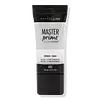What's inside
What's inside
 Key Ingredients
Key Ingredients

No key ingredients
 Benefits
Benefits

 Concerns
Concerns

 Ingredients Side-by-side
Ingredients Side-by-side

Dimethicone
EmollientWater
Skin ConditioningCyclopentasiloxane
EmollientButylene Glycol
HumectantDimethicone/Vinyl Dimethicone Crosspolymer
Skin ConditioningMethyl Methacrylate Crosspolymer
Cyclohexasiloxane
EmollientDimethicone Crosspolymer
Emulsion StabilisingPhenyl Trimethicone
Skin ConditioningPEG-10 Dimethicone
Skin ConditioningMagnesium Sulfate
Cetyl PEG/PPG-10/1 Dimethicone
EmulsifyingCaprylyl Glycol
EmollientPolymethylsilsesquioxane
Vinyl Dimethicone/Methicone Silsesquioxane Crosspolymer
Titanium Dioxide
Cosmetic ColorantSilica Silylate
EmollientSynthetic Beeswax
Emulsion StabilisingEthylhexylglycerin
Skin ConditioningPicea Mariana Bark Extract
AntioxidantPrunus Mume Flower Extract
Skin ConditioningLonicera Japonica Flower Extract
Skin ConditioningNelumbo Nucifera Flower Extract
Skin ConditioningCentella Asiatica Extract
CleansingCentella Asiatica Leaf Extract
Skin ConditioningCentella Asiatica Root Extract
Skin ConditioningAsiaticoside
AntioxidantAsiatic Acid
Skin ConditioningMadecassoside
AntioxidantMadecassic Acid
Skin ConditioningSodium Hyaluronate
HumectantHyaluronic Acid
HumectantHydrolyzed Hyaluronic Acid
HumectantHydroxypropyltrimonium Hyaluronate
Hydrolyzed Sodium Hyaluronate
Skin ConditioningPotassium Hyaluronate
Skin ConditioningSodium Hyaluronate Crosspolymer
HumectantSodium Acetylated Hyaluronate
HumectantAllantoin
Skin ConditioningGlycine
BufferingSerine
MaskingGlutamic Acid
HumectantAspartic Acid
MaskingLeucine
Skin ConditioningAlanine
MaskingLysine
Skin ConditioningArginine
MaskingTyrosine
MaskingPhenylalanine
MaskingValine
MaskingThreonine
Proline
Skin ConditioningIsoleucine
Skin ConditioningHistidine
HumectantMethionine
Skin ConditioningCysteine
AntioxidantPolyglutamic Acid
Skin ConditioningPentylene Glycol
Skin Conditioning1,2-Hexanediol
Skin ConditioningTrisodium Ethylenediamine Disuccinate
Aluminum Hydroxide
EmollientTriethoxycaprylylsilane
CI 77491
Cosmetic ColorantCI 77492
Cosmetic ColorantParfum
MaskingDimethicone, Water, Cyclopentasiloxane, Butylene Glycol, Dimethicone/Vinyl Dimethicone Crosspolymer, Methyl Methacrylate Crosspolymer, Cyclohexasiloxane, Dimethicone Crosspolymer, Phenyl Trimethicone, PEG-10 Dimethicone, Magnesium Sulfate, Cetyl PEG/PPG-10/1 Dimethicone, Caprylyl Glycol, Polymethylsilsesquioxane, Vinyl Dimethicone/Methicone Silsesquioxane Crosspolymer, Titanium Dioxide, Silica Silylate, Synthetic Beeswax, Ethylhexylglycerin, Picea Mariana Bark Extract, Prunus Mume Flower Extract, Lonicera Japonica Flower Extract, Nelumbo Nucifera Flower Extract, Centella Asiatica Extract, Centella Asiatica Leaf Extract, Centella Asiatica Root Extract, Asiaticoside, Asiatic Acid, Madecassoside, Madecassic Acid, Sodium Hyaluronate, Hyaluronic Acid, Hydrolyzed Hyaluronic Acid, Hydroxypropyltrimonium Hyaluronate, Hydrolyzed Sodium Hyaluronate, Potassium Hyaluronate, Sodium Hyaluronate Crosspolymer, Sodium Acetylated Hyaluronate, Allantoin, Glycine, Serine, Glutamic Acid, Aspartic Acid, Leucine, Alanine, Lysine, Arginine, Tyrosine, Phenylalanine, Valine, Threonine, Proline, Isoleucine, Histidine, Methionine, Cysteine, Polyglutamic Acid, Pentylene Glycol, 1,2-Hexanediol, Trisodium Ethylenediamine Disuccinate, Aluminum Hydroxide, Triethoxycaprylylsilane, CI 77491, CI 77492, Parfum
Water
Skin ConditioningDimethicone
EmollientGlycerin
HumectantDimethicone Crosspolymer
Emulsion StabilisingPropylene Glycol
HumectantPolyglyceryl-3 Disiloxane Dimethicone
Skin ConditioningVinyl Dimethicone/Methicone Silsesquioxane Crosspolymer
Methyl Methacrylate Crosspolymer
Boron Nitride
AbsorbentPhenoxyethanol
PreservativeCaprylyl Glycol
EmollientPolyacrylamide
Ammonium Polyacryloyldimethyl Taurate
Emulsion StabilisingC13-14 Isoparaffin
EmollientTetrasodium EDTA
Citric Acid
BufferingLaureth-7
EmulsifyingCI 77891
Cosmetic ColorantCI 77491
Cosmetic ColorantCI 77492
Cosmetic ColorantCI 77288
Cosmetic ColorantWater, Dimethicone, Glycerin, Dimethicone Crosspolymer, Propylene Glycol, Polyglyceryl-3 Disiloxane Dimethicone, Vinyl Dimethicone/Methicone Silsesquioxane Crosspolymer, Methyl Methacrylate Crosspolymer, Boron Nitride, Phenoxyethanol, Caprylyl Glycol, Polyacrylamide, Ammonium Polyacryloyldimethyl Taurate, C13-14 Isoparaffin, Tetrasodium EDTA, Citric Acid, Laureth-7, CI 77891, CI 77491, CI 77492, CI 77288
Ingredients Explained
These ingredients are found in both products.
Ingredients higher up in an ingredient list are typically present in a larger amount.
Caprylyl Glycol is a humectant and emollient, meaning it attracts and preserves moisture.
It is a common ingredient in many products, especially those designed to hydrate skin. The primary benefits are retaining moisture, skin softening, and promoting a healthy skin barrier.
Though Caprylyl Glycol is an alcohol derived from fatty acids, it is not the kind that can dry out skin.
This ingredient is also used as a preservative to extend the life of products. It has slight antimicrobial properties.
Learn more about Caprylyl GlycolCi 77491 is also hydrated iron III oxide. It's sole purpose is to give a red/pink hue to products.
Iron III oxides are classified as inorganic chemicals for coloring.
Synthetically created Ci 77491 is considered safer than those naturally found. This is because the synthetically created version may contain less impurities. Iron oxides are generally non-toxic and non-allergenic.
Learn more about CI 77491Ci 77492 is also hydrated iron III oxide. It's sole purpose is to give a yellow hue to products.
Iron III oxides are classified as inorganic chemicals for coloring.
Synthetically created Ci 77492 is considered safer than those naturally found. This is because the synthetically created version may contain less impurities. Iron oxides are generally non-toxic and non-allergenic.
Learn more about CI 77492Dimethicone is a type of synthetic silicone created from natural materials such as quartz.
What it does:
Dimethicone comes in different viscosities:
Depending on the viscosity, dimethicone has different properties.
Ingredients lists don't always show which type is used, so we recommend reaching out to the brand if you have questions about the viscosity.
This ingredient is unlikely to cause irritation because it does not get absorbed into skin. However, people with silicone allergies should be careful about using this ingredient.
Note: Dimethicone may contribute to pilling. This is because it is not oil or water soluble, so pilling may occur when layered with products. When mixed with heavy oils in a formula, the outcome is also quite greasy.
Learn more about DimethiconeDimethicone Crosspolymer is a silicone created by modifying dimethicone with hydrocarbon side chains. Due to its large size, it does not penetrate skin. It is considered non-occlusive.
Dimethicone Crosspolymer is used to stabilize and thicken products. It also helps give products a silky feel.
This ingredient comes as a powder made up of small, porous, microbeads. It is used to add a silky feel to products and also helps absorb oil.
This ingredient is used in makeup and skincare to thicken formulas, reduce shine, and give skin a silky-smooth feel.
It’s a white silicone powder that sits in fine lines and pores to blur their appearance though its effectiveness depends on the particle size.
You'll typically find this ingredient in amounts between 0.1-20%.
Learn more about Vinyl Dimethicone/Methicone Silsesquioxane CrosspolymerWater. It's the most common cosmetic ingredient of all. You'll usually see it at the top of ingredient lists, meaning that it makes up the largest part of the product.
So why is it so popular? Water most often acts as a solvent - this means that it helps dissolve other ingredients into the formulation.
You'll also recognize water as that liquid we all need to stay alive. If you see this, drink a glass of water. Stay hydrated!
Learn more about Water